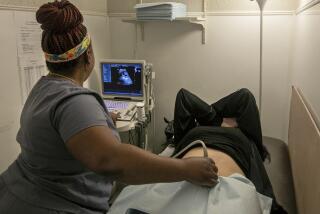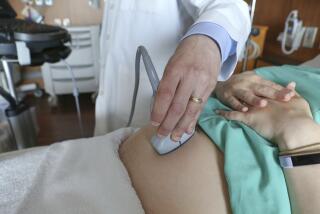Developments in Brief : Early Test for Birth Defects Appears Safe
- Share via
A new technique to detect birth defects between the ninth and 12th weeks of pregnancy by examining fetal cells appears to be safe and reliable, according to an analysis of 1,000 consecutive cases of the procedure by researchers at the UC San Francisco Medical Center.
The procedure, called chorionic villus sampling, may become an alternative to the more widely used technique of amniocentesis, which has the disadvantage of needing to be performed between the 16th and 20th weeks of pregnancy.
Earlier diagnosis allows the mother the option of terminating her pregnancy during the first trimester, which is considered safer than a second-trimester abortion. In the future, doctors also hope to use the technique to detect fetal conditions that can be treated before birth.
To sample the chorionic villus cells, which are genetically identical to fetal cells, physicians pass a thin tube called a catheter into the uterus of the pregnant woman and obtain a tiny piece of the placenta. The chorionic villi are part of the placenta, the blood-rich structure through which the fetus takes in oxygen and food and eliminates wastes.
In amniocentesis, a needle is passed through the abdomen to obtain cells floating in the fluid surrounding the fetus.
The techniques, according to the UC San Francisco researchers, appear to be equally accurate in detecting such conditions as Down’s syndrome and sickle-cell anemia. Villus sampling was associated with spontaneous abortions in 1.5% of cases, compared to a 0.5% spontaneous abortion rate with amniocentesis. The report was published in the June issue of the American Journal of Obstetrics and Gynecology.






